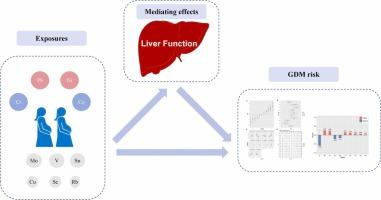白蛋白介导母亲暴露于多种金属和妊娠期糖尿病之间的关系:来自广西出生队列研究的发现
IF 3.6
3区 医学
Q2 BIOCHEMISTRY & MOLECULAR BIOLOGY
Journal of Trace Elements in Medicine and Biology
Pub Date : 2025-08-30
DOI:10.1016/j.jtemb.2025.127736
引用次数: 0
摘要
背景:金属与妊娠期糖尿病(GDM)的风险显著相关。然而,肝功能对金属与GDM风险之间关系的影响仍未被探索。本研究旨在探讨母体肝功能是否介导多种金属暴露与孕妇GDM之间的关系。方法本横断面研究纳入广西出生队列研究中的1321名孕妇。在怀孕不到24周的孕妇中测量了血液中22种金属的浓度和血清中12种肝功能生物标志物的水平。妊娠24-28周通过口服葡萄糖耐量试验(OGTT)诊断GDM。共纳入292例GDM孕妇和1029例非GDM孕妇。通过最小绝对收缩和选择算子(LASSO)回归筛选,采用贝叶斯核机回归(BKMR)模型研究母体血液多金属暴露对GDM风险的综合影响,并采用限制三次样条分析、分位数g计算模型和广义线性回归模型评估金属与GDM的相关性。此外,还进行了中介分析,以确定肝功能生物标志物是否介导金属与GDM风险之间的关联。结果slasso回归分析显示10种金属与GDM风险相关,BKMR分析显示多种金属联合暴露与GDM风险呈正相关(OR: 1.275, 95 % CI: 1.004-1.618)。在广义线性模型中,血铬(Cr)和钴(Co)是GDM的保护因素(OR: 0.575, 95 % CI: 0.394-0.835; OR: 0.838, 95 % CI: 0.705-0.995),而血铅(Pb)和镍(Ni)是GDM的危险因素(OR: 1.695, 95 % CI: 1.110-2.257; OR: 1.444, 95 % CI: 1.080-1.930)。根据中介分析,白蛋白介导血铅暴露与GDM风险的相关性为13.2 % (P = 0.039),血Co暴露与GDM风险的相关性为8.3 % (P = 0.027)。结论妊娠期Pb、Ni暴露可增加妊娠期GDM的发生风险,Cr、Co暴露可降低妊娠期GDM的发生风险。白蛋白可能在铅和钴暴露与GDM的关联中起关键作用。本文章由计算机程序翻译,如有差异,请以英文原文为准。

Albumin mediates the association between maternal exposure to multiple metals and gestational diabetes mellitus: Findings from the Guangxi Birth Cohort Study
Background
Metals are significantly associated with the risk of gestational diabetes mellitus (GDM). However, the effects of liver function on the relationships between metals and GDM risk remain unexplored. This study aimed to investigate whether maternal liver function mediates the association between exposure to multiple metals and GDM among pregnant women.
Methods
This cross-sectional study included 1321 pregnant women from the Guangxi Birth Cohort Study. The concentrations of 22 metals in the blood and the levels of 12 liver function biomarkers in the serum were measured in pregnant women at less than 24 gestational weeks. GDM was diagnosed by an oral glucose tolerance test (OGTT) at 24–28 weeks of gestation. A total of 292 pregnant women with GDM and 1029 pregnant women without GDM were included. After least absolute shrinkage and selection operator (LASSO) regression screening, a Bayes kernel machine regression (BKMR) model was used to study the combined effect of maternal blood polymetallic exposure on the risk of GDM, and restricted cubic spline analysis, a quantile g-computation model and a generalized linear regression model were used to evaluate the associations between metals and GDM. Moreover, mediation analyses were performed to determine whether liver function biomarkers mediate the associations between metals and GDM risk.
Results
LASSO regression analysis revealed that 10 metals were associated with GDM risk, and BKMR analysis suggested a positive association between combined exposure to multiple metals and GDM risk (OR: 1.275, 95 % CI: 1.004–1.618). Blood chromium (Cr) and cobalt (Co) were protective factors for GDM (OR: 0.575, 95 % CI: 0.394–0.835; OR: 0.838, 95 % CI: 0.705–0.995), whereas blood lead (Pb) and nickel (Ni) were risk factors for GDM (OR: 1.695, 95 % CI: 1.110–2.257; OR: 1.444, 95 % CI: 1.080–1.930) in the generalized linear model. According to the mediation analysis, albumin mediated the association between blood Pb exposure and GDM risk by 13.2 % (P = 0.039) and the association between blood Co exposure and GDM risk by 8.3 % (P = 0.027).
Conclusion
The results suggest that exposure to Pb and Ni during pregnancy increases the risk of GDM, whereas exposure to the trace elements Cr and Co can reduce the risk of GDM. Albumin may play a key role in the association of Pb and Co exposure with GDM.
求助全文
通过发布文献求助,成功后即可免费获取论文全文。
去求助
来源期刊
CiteScore
6.60
自引率
2.90%
发文量
202
审稿时长
85 days
期刊介绍:
The journal provides the reader with a thorough description of theoretical and applied aspects of trace elements in medicine and biology and is devoted to the advancement of scientific knowledge about trace elements and trace element species. Trace elements play essential roles in the maintenance of physiological processes. During the last decades there has been a great deal of scientific investigation about the function and binding of trace elements. The Journal of Trace Elements in Medicine and Biology focuses on the description and dissemination of scientific results concerning the role of trace elements with respect to their mode of action in health and disease and nutritional importance. Progress in the knowledge of the biological role of trace elements depends, however, on advances in trace elements chemistry. Thus the Journal of Trace Elements in Medicine and Biology will include only those papers that base their results on proven analytical methods.
Also, we only publish those articles in which the quality assurance regarding the execution of experiments and achievement of results is guaranteed.

 求助内容:
求助内容: 应助结果提醒方式:
应助结果提醒方式:


